First network centric war
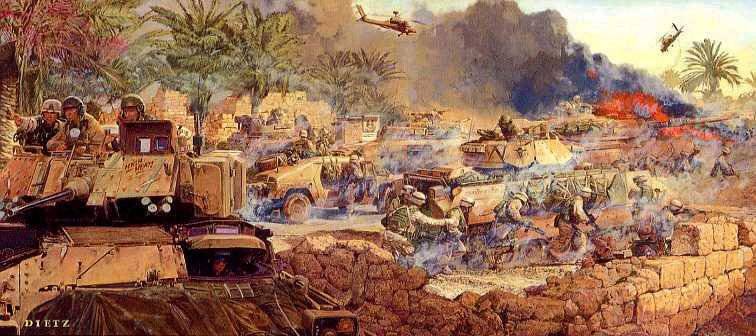
“We must recognize that so far [Russian] military science has not revealed a clear generalized type of modern war and armed conflict,” said Russian Defense Minister S. Ivanov in a speech at a meeting of the 24 Academy of Military Sciences in January 2004.
After almost ten years, this situation has not changed. The experience of recent army operations in Yugoslavia, Afghanistan and Iraq remained unclaimed in the Armed Forces of Russia. Such a conclusion can be drawn from the refusal of the transition to the only currently generalized type of modern war called Network Centric Warfare (network-centric hostilities). The 5 approved February 2010 of the year The military doctrine of the Russian Federation does not contain similar language or its characteristic components.
The concept of network-centric hostilities was published in 1998 in an article by Vice Admiral Arthur Sebrowski and US Department of Defense Fellow John Garstka. The concept was based on a multiple increase in the combat power of the armed forces without increasing their numbers, only by raising to a qualitatively different level the technology of managing the armed forces by creating a single information network connecting all participants in the fighting in real time. This decision made it possible to change to the opposite value the balance of forces between the attacking and the defending sides, provided that the latter does not possess such technology.
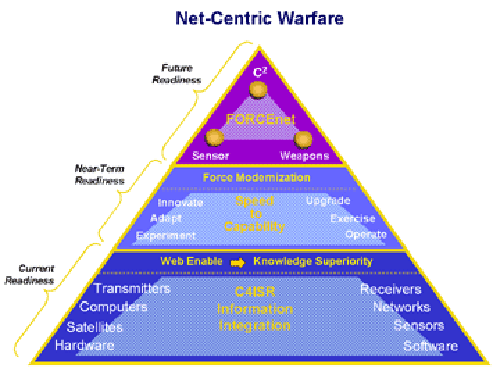
Network Centric Warfire conceptual diagram
The new concept of warfare has the following effects:
- the reaction time during military operations is shorter by an order of magnitude;
- the continuity of the process of planning, conducting and logistics of military operations;
- a single level of operational and tactical awareness;
- self-synchronization of actions in general combat;
- a combination of the spatial distribution of the armed forces and the concentration of their fire impact on the enemy.
The technology of network-centric hostilities relies on the latest technical advances in communications and automation. Communication is based on the principle of a self-healing network that transmits digital data, voice information and streaming video through common channels. Automation of command and control is provided by creating a computer system, the computing power of which is distributed down to the level of combat vehicles and individual infantrymen.
It is necessary to emphasize the fundamental difference between the concept of Network Centric Warfare from the previously developed concepts of Blitzkrieg (Alfred von Schlieffen, 1905 year) and deep operations (Victor Triandafillov, 1931 year). Implemented respectively at the beginning and end of World War II, these concepts are based on the historically established hierarchical system of command and control of troops — all information from advanced units rises to the headquarters level, summarizes and, in the form of combat orders, descends again to the level of fire support units. The reaction time to a change in the operational-tactical situation is determined by the bandwidth capabilities of the communication channels and the speed of information processing at the headquarters level. Management at all stages is completely centralized: the disruption of the headquarters or communication channels leads to the disorganization of troops.
The ratio of the decision time between the Network Centric Warfire and deep operation
Unlike Blitzkrieg and deep operations, the concept of Network Centric Warfare provides for the formation of horizontal links between advanced units and fire support units. The staff level is involved only in order to monitor the implementation of the previously outlined plan of hostilities and make adjustments to it, taking into account the changing situation. Troop control in real time is decentralized while maintaining centralization of combat planning.
The concept of a deep operation still forms the basis of the military doctrine of the Armed Forces of the Russian Federation. The concept of network-centric hostilities is included in the US military doctrine (Joint Vision 2010 and Joint Vision 2020 versions) and put into practice in 2003 in the war between the US-British coalition, on the one hand, and Iraq, on the other.
In the Russian militaryhistorical literature, the military operations of the US-British coalition in the Second Iraq War are officially interpreted as conducting an air-ground war (a kind of deep operation) similar to the actions of the US armed forces in the first Iraq war, Yugoslavia and Vietnam. However, the high level of military potential of both warring parties, the transience of the conflict and the paradoxical balance of forces of the advancing and the defending directly indicate a network-centric war.
In 2003, Iraq possessed numerous armed forces with many years of combat experience, including military confrontation with American forces. Iraqi forces included 23 divisions of the ground forces and the Republican Guard with a strength of 230 thousand people and 200 thousand people in aviation and air defense forces, which were armed with 2200 tanks (including 700 T-72s), 3000 armored personnel carriers and infantry fighting vehicles, 4000 guns, mortars and MLRS, 100 medium-range ballistic missiles, 500 combat aircraft and helicopters, 100 mobile air defense systems. In addition, there were irregular military units of up to 40 thousand people armed with a rifle weapons, rocket-propelled grenade launchers and off-road cars. The number of reservists was 650 thousand people.
The forces of the US-British coalition included 6 divisions of ground forces and marine corps with a strength of 110 thousand people and 180 thousand people in aviation and navywhich were armed with 500 tanks, 1200 BMP and armored personnel carriers, 900 guns, mortars and MLRS, 1100 medium-range cruise missiles, 1300 combat aircraft and helicopters, 200 mobile air defense systems.
The numerical superiority of the Iraqi armed forces over the US-British coalition was:
- in manpower in 1,48 times, including in 2,09 times in the number of ground troops;
- in tanks in 4,4 times;
- in BMP and BTR in 2,5 times;
- in artillery in 4,4 times.
The numerical superiority of the American-British coalition over the Iraqi armed forces was:
- in mobile air defense systems in 2 times;
- in aviation 2,6 times;
- in medium-range missiles 11 times.
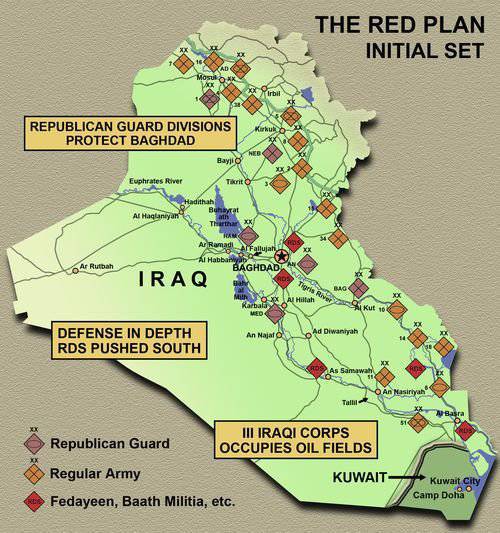
Location of Iraqi forces on 19 March 2003 of the year
In exact accordance with the concept of a deep operation (defensive in this case) and based on the numerical superiority of the enemy in aviation and medium-range missiles, the Iraqi troops were dispersed to the maximum extent in part of the country with rugged terrain and natural obstacles:
- on the east bank of the Tigris River along the Iran-Iraq border (southern slopes of the Iranian Highlands);
- in the interfluve of the Tigris and Euphrates (marshy lowland with irrigated agriculture).
The western part of Iraq’s territory between the right bank of the Euphrates River and the Saudi-Iraqi border, which occupies about half of the country’s area and is covered with rocky desert, was practically free from the deployment of troops and armaments. Fortifications were created around major cities.
As a result, the Iraqi troops were turned to the south-west, having a neutral state (Iran) in the rear, creating a deeply echeloned defense with three lines of natural obstacles - the Euphrates River, the marshy interfluve and the Tigris River.
The defense of the Iraqi divisions was built in the form of a set of strong points located along the perimeter of the cities. Field defensive positions in the form of full profile trenches and caponiers of combat vehicles were combined with urban defensive positions in the form of buildings and structures adapted for the shelters of combat vehicles and long-term firing points.
The strategic defensive plan of the Iraqi armed forces was based on the abandonment of the struggle for air superiority and the imposition of fights on previously prepared positions with inflicting unacceptable damage on the enemy. The center of defense was Baghdad, where most of the air defense forces and the most combat-ready military units were concentrated. In connection with the quantitative and qualitative superiority of enemy aviation, it was decided to abandon the combat use of its own aviation. In the event of a breakthrough of field positions, it was planned to transfer combat operations to the line of urban development, using the latter as protective structures. In the enemy's rear on supply lines it was planned to deploy sabotage operations by forces of irregular military formations.
The ground forces of the American-British coalition before the beginning of the campaign occupied a bridgehead in Kuwait, bordering Iraq in the south-east. Aviation was based in Kuwait, other Arab countries of the Persian Gulf, and also on aircraft carriers. Medium-range cruise missiles were part of tactical aviation ammunition and were deployed on military ships and submarines. A small number of special operations forces (about 4000 people) were located in Jordan near the northern border of Iraq.
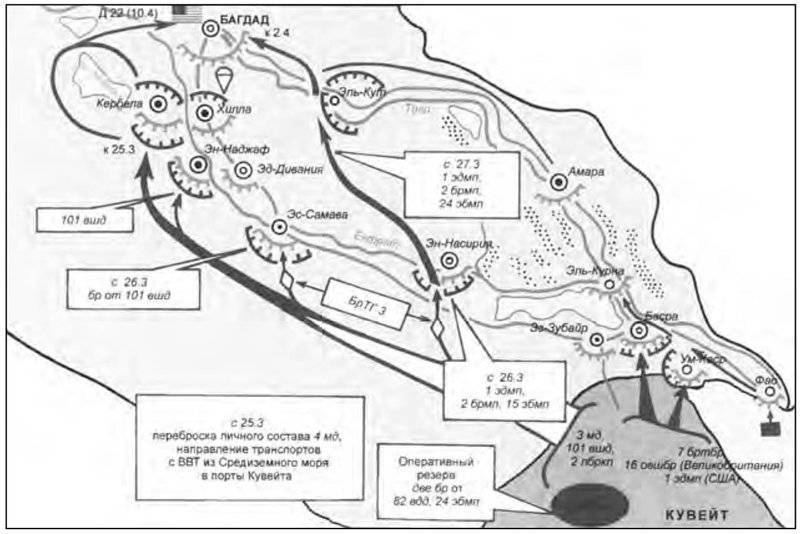
US-British coalition fighting in March-April 2003
The strategic offensive plan of the American-British coalition envisaged the conquest of full air supremacy by suppressing air defense and creating a no-fly zone for enemy aircraft over the entire territory of Iraq. After achieving this result, it was planned to block Iraqi military units in the places of their deployment with the help of air strikes against enemy columns on the march. In addition, the aircraft should have consistently destroyed the enemy’s military equipment deployed to field defense positions around fortified areas and provide support to assault groups in the urban environment.
The ground forces of the American-British coalition were assigned three tasks:
- surround a large grouping of Iraqi troops in the fortified area around Basra;
- To inflict a flank attack on Iraqi troops located in the first echelon of the defense between the Tigris and Euphrates rivers, with the further advancement and destruction of enemy strongholds along the Basra-Baghdad highway;
- to carry out a raid to the depth of 400 km along the outlying Iraqi desert areas along the leading edge of enemy defenses across the Euphrates River and seize the center of defense of Baghdad.
Military operations were launched on 19 March 2003, the invasion of northern Iraq (areas inhabited by Kurds) by special operations forces. The next day, a massive rocket-bombing attack was made on air defense complexes, radar stations and airfields to the entire depth of Iraqi territory. The task of winning air superiority and creating an unmanned zone was solved. March 21 aviation attacked the Iraqi army’s border control posts, allowing the ground forces of the US-British coalition to move into Iraqi territory. One British division blocked a fortified area around Basra, three American divisions (two expeditionary divisions of the Marine Corps and 82-I air assault) hit the flank of the first echelon of the Iraqi forces, two US divisions (3-I mechanized and 101-I air assault ) went to the raid on Baghdad.
Broken launchers of the Iraqi C-300 SAM
From this point on, the US-British aviation began to destroy Iraqi military equipment on the march and in field defensive positions. Every day only tactical aviation aircraft carried out 1700 sorties on average, without taking into account the actions of attack helicopters and strategic bombers B-52. The latter directly supported ground troops on duty in the air over combat areas, striking guided laser-guided bombs at targets highlighted by advanced aircraft gunners.
Four days after the start of the Kuwaiti-Iraqi border crossing, the 3-I mechanized division operating in the first echelon of the offensive reached the outer line of the defense of Baghdad, located in the area of the city of Karbala. After the suppression of the field defensive positions, one of the brigades of the 3 division in combat broke through to the south-west of Baghdad, located beyond the Tigris River. Twelve days after the beginning of the offensive from the southeast, the US Marine Corps approached Baghdad, which in its way bypassed the blocked fortified areas of Al-Nasiriyah and Kut between the Tigris and Euphrates rivers. The 101-I and 82-I air-assault divisions operated in the second echelon of the offensive, ensuring the protection of their communications.
The defeat of the Iraqi armored column on the march
Baghdad was taken to the ring. For three days, American-British aircraft suppressed the defensive positions of Iraqi troops directly within the city, after which the advanced units of the 3-th mechanized division entered it. All the counterattacks of the most combat-ready divisions of the Republican Guard of Iraq “Medina” and “Nebuchadnezzar”, as well as army special forces were repulsed with heavy losses for the defenders. 9 on April began the mass desertion of Iraqi troops throughout the country, with the exception of Tikrit, the hometown of the President of Iraq, whose garrison ceased resistance on April 13.
At first glance, the actions of the American-British coalition look like a classic air-ground offensive operation - the conquest of air superiority, the air blockade of the defending enemy in the places of its deployment, the air support for the advancing ground units. However, this development was not a surprise for the Iraqi command, which had previously built deeply echeloned defense in the form of fortified areas, having accumulated in them a sufficient amount of ammunition and food for autonomous combat operations for the period up to 60 days. In the settlements themselves in the houses were equipped shelters for military equipment and long-term emplacements, underground communications were used to move the infantry.
The aim of the Iraqi command was to draw the American-British coalition into protracted battles. Even the fourth day of the onset of the 3 th mechanized division to the distant approaches to Baghdad did not contradict this plan, since the enemy then had to move from a raid across the desert territory to frontal assault on field defensive positions, and then be drawn into urban battles with elite Iraqi units troops.
Trophy Iraqi MiG-25
The cause of the short-term defeat of the Iraqi armed forces was the effect of the implementation of the concept of network-centric hostilities, first used in practice by the American armed forces. Without exception, the strongholds in the offensive zone of the coalition forces, regardless of their location (in field conditions or within the city limits), were destroyed by the attackers without any special damage to themselves, despite the numerical superiority of the defenders in military equipment and manpower. For the period from March 19 to April 13, the losses of the killed American-British coalition amounted to 2003 man, the Iraqi armed forces - 172 man.
The entire Iraqi airspace was monitored round-the-clock with the help of American long-range radar reconnaissance and AWACS command and control aircraft. In connection with the refusal of the Iraqi command to use its air force, this system was mainly used for the dispatch control of flights of airplanes and helicopters of the American-British coalition. The J-Stars radar system installed onboard the Boeing E-250A / C aircraft was used for the operational control of the ground situation to a depth of 8 km from the front line, warning the ground forces of enemy movements and air and artillery strikes. Sources of radio emission at the location of Iraqi forces, including radars, radio transmitters, repeaters and EW, were detected, suppressed and destroyed with the help of electronic reconnaissance aircraft and self-guided missiles.
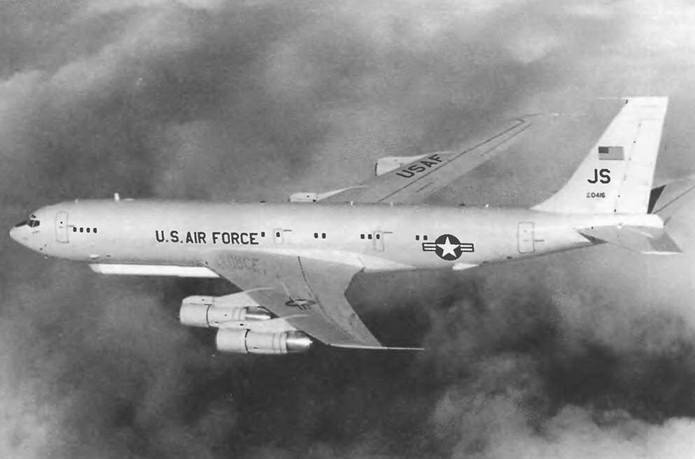
Boeing E-8A / C J-Stars Ground Purpose DRLO Aircraft
The use of the new integrated communications and control system FBCB2 (Force XXI Battle Command Brigade and Below), developed from 1995, in the Second Iraq war played a key role in the successful actions of the ground forces. Her experimental versions were previously tested in military conflicts in Yugoslavia (1999 year) and Afghanistan (2001 year). FBCB2 linked automated systems for reconnaissance, positioning, fire control, situational awareness, combat planning and logistics of land forces, and also provided data exchange with automated systems of other types of armed forces and joint command.
FBCB2 terminals were located directly onboard tanks, infantry fighting vehicles, armored personnel carriers, self-propelled guns, rocket launchers and multi-purpose off-road vehicles of the United States Army and Marine Corps. The terminals were also equipped with mobile command posts, technical reconnaissance and fire control systems for artillery and rocket units, advanced artillery and air gunners. The terminals were connected to a two-level radio communications network, including the EPLRS / SINCGARS air segment and the INMARSAT space segment. Data exchange was carried out within the framework of a virtual network of tactical Internet.
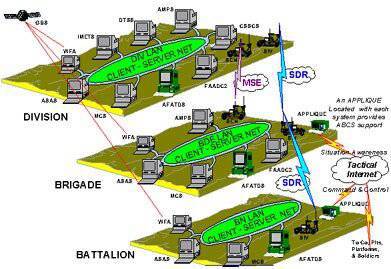
Information network ACCS FBCB2
The commanders of combat vehicles and military units before the platoon / battery inclusive in real time on the displays of their terminals had a display of the current tactical situation, including the location of the enemy positions and their parts. In this regard, all attacks on the defensive positions of the Iraqi army were carried out mainly from the flanks and rear. The artillery armament of American tanks and infantry fighting vehicles was used at extreme distances outside the zone of aimed fire of artillery armament of Iraqi combat vehicles.
The commanders of the advanced divisions of the American divisions on the battlefield were given communication opportunities to directly interact with artillery units and tactical, in some cases, strategic aviation. Iraqi artillery was suppressed by multiple rocket launchers immediately after the determination of its positions according to radar reconnaissance for the trajectories of the projectile flights during the first sighting shots. After gaining air supremacy, the main type of combat use of the aviation of the American-British coalition (90 percent of sorties) was airborne defenses in combat areas and air support to their ground forces on the battlefield (using advanced aircraft gunners) or behind Iraqi troops (with using radar guidance).
As a result, the fire contact of the attackers and the defenders took place unilaterally, which greatly influenced the moral and psychological stability of the Iraqi military personnel. The inability to realize not only the defense plan, but also the elementary fulfillment of their military duty (to damage the enemy even at the cost of his own death) demoralized first the Iraqi army and then the Republican Guard of Iraq.
On the other hand, full possession of tactical information, preventive use of fire weapons, the practical absence of casualties from the attackers and the uninterrupted logistical support allowed them to destroy enemy forces in parts, even without a quantitative superiority in ground weapons and manpower.
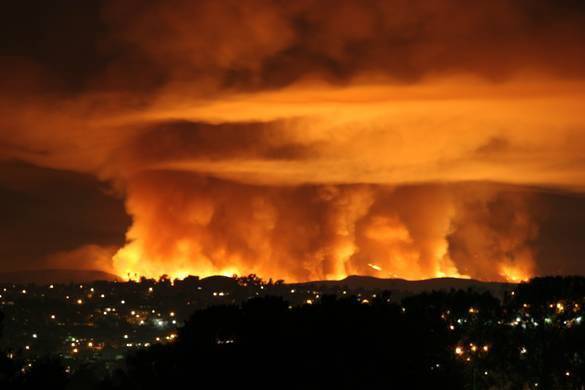
Bombardment of the Baghdad City Districts
At the same time, one should not exaggerate the factor of air supremacy in the skies of Iraq. According to the estimates of the US ground forces command, the effectiveness of field defense defensive bombardments averaged 20 percent. To protect against air strikes, the Iraqis used a variety of camouflage and disinformation measures for the air enemy: burning automobile tires near combat-ready tanks and infantry fighting vehicles (to imitate their destruction), manually destroying stone mounds of parabolic trenches and caponiers, hiding equipment and personnel in residential buildings until start a ground attack, etc.
To destroy the remaining 80 percent of field defensive positions (including Iraqi combat vehicles buried in the ground), American tank and mechanized units used regular artillery weapons equipped with thermal sights and laser rangefinders. The shooting distance was from 2 to 2,5 km. When attacking in populated areas, assault groups of infantry used portable missile systems with high-explosive fragmentation warheads and guided bombs on targets in urban areas. The shooting / aiming distance was from 1 to 1,5 km.
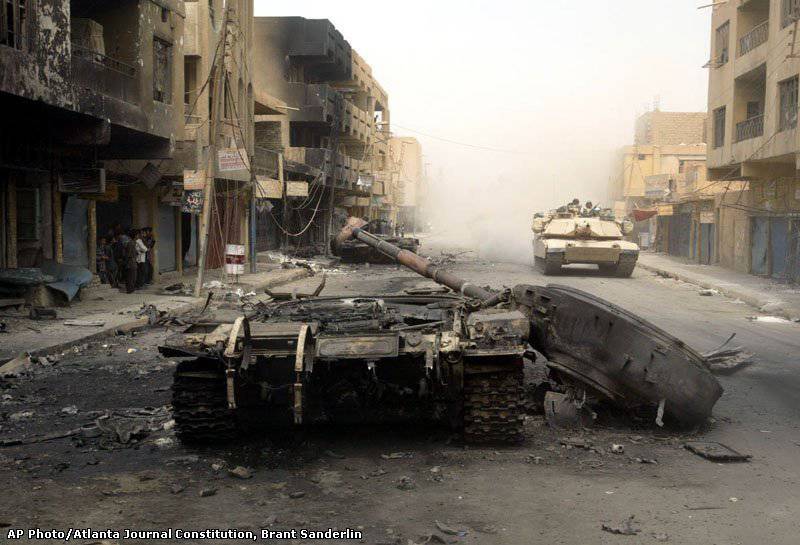
Padded Iraqi tanks on the streets of Baghdad
The few attempts by Iraqi troops to counterattack each time stumbled upon the situational awareness of the American forces at an early stage about the transfer and accumulation of forces of the defenders. A typical example is the night counterattack attempt by two Republican Guard brigades, supported by 70 tanks, to bridgehead one battalion of the 3 Mechanized Division, reinforced by 10 Abrams and 4 BMP Bradley tanks, in urban development in Baghdad. Stumbling into a bombing strike and artillery fire before the start of the counterattack and having lost half of the killed and wounded in dense pre-battle order, the Iraqis were forced to retreat.
The unwillingness of Iraqi troops to conduct urban battles in the conditions of high-precision bombing and artillery fire at extreme distances is well illustrated by the tactics used by the 3-I mechanized division to establish control over Baghdad. The Thunder run method was used - high-speed raids of armored vehicles on city arteries with attacks on enemy firing points identified during raids. The last high-speed raid was accompanied by the landing of infantry at the intersections of highways with the deployment of strong points and ended with the seizure of a complex of government buildings in the city center. The contact of the Iraqi Armed Forces Command with President Saddam Hussein was lost. Night counterattacks were once again disrupted. The next morning, the resistance of the Iraqi army and the Republican Guard was broken. Armed conflict has passed into the stage of guerrilla war.
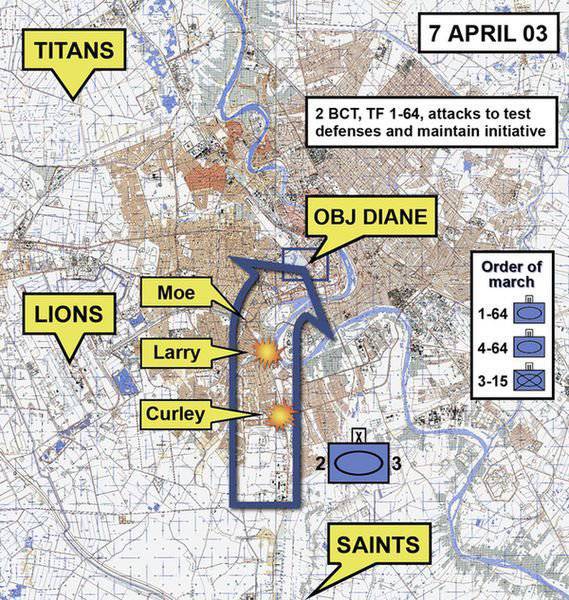
Scheme of the last raid Thunder run
The Network Centric Warfare technology in the Iraq war was largely built on speeding up the delivery of intelligence to the advanced units of the American army. Increased situational awareness helped them each time advance the opponent in their decision making. At the same time, special attention was paid to the priority identification and destruction of the command posts of the Iraqi troops, after which their combat command, built on a hierarchical basis, ceased to exist as an organized system.
The delay in obtaining intelligence about the Iraqi forces immediately affected the pace of the offensive - the absence of the usual red icons (designation of enemy positions) on the displays of the FBCB2 terminals acted as a brake light on the commanders of the advanced units of the American troops. For example, the sandstorm over Baghdad and the associated temporary suspension of reconnaissance aircraft forced American troops to proceed to the so-called siege of Baghdad in accordance with an official statement by US Secretary of Defense Donald Rumsfeld. However, active offensive actions immediately resumed after changes in weather conditions.
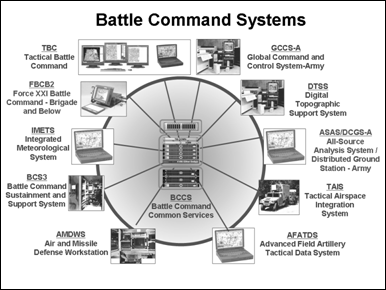
Combining automated systems Battle Command Systems US Armed Forces
After the Iraq war, 2003, the development of the material basis for the conduct of network-centric hostilities proceeded at an accelerated pace. In the US armed forces informational docking of the automation systems of the ground forces, air defense, aviation and navy was made using the DIB (DCGS Integrated Backbone) software interface. In the space and air segment, the transition to broadband is completed. The functionality of the FBCB2 automated system has been extended to С4 level. Completed equipping all units of the Army and Marine Corps with transportable terminals. At present, in accordance with the program of the Joint Battle Command Platform, we equip military personnel of permanent readiness units with wearable terminals. In 2014, it is planned to test the digital battlefield Digital Battle Field, which does not require the mandatory use of a satellite navigation system and laser illumination of targets.
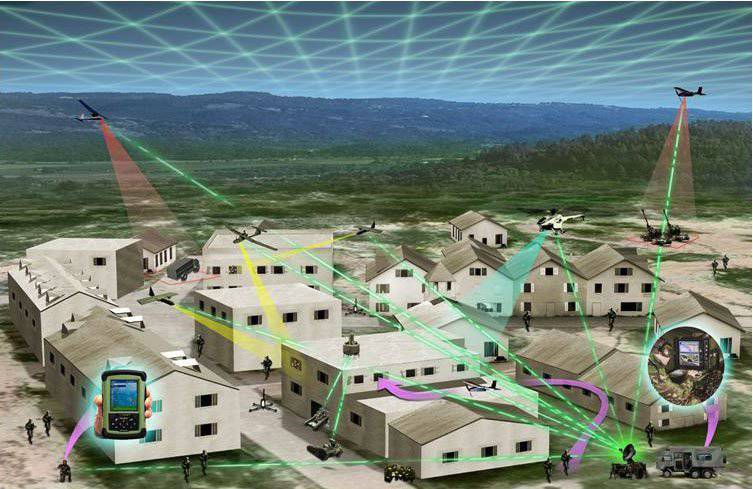
HART Intelligence Network
In 2012, the number of unmanned aerial vehicles (7400 units) in the US military exceeded the number of main battle tanks (7200 units). A large flight fleet of UAVs, together with a broadband radio network and a network of computers, makes it possible to form an extensive fault-tolerant multispectral reconnaissance network of the HART type (Heterogeneous Airborne Reconnaissance Team) on a theater scale.
Since 2010, the Cyber Command has been operating under the authority of the Strategic Command and operating the global information network GIG (Global Information Grid) of the US Armed Forces. Raising the information system to the same level as the nuclear triad (ballistic missiles, submarines and heavy bombers) shows the strategic importance of implementing the concept of Network Centric Warfare to achieve technological superiority over the enemy.
The functional structure of the Global Information Grid network
Unfortunately, the Armed Forces of Russia still rely on the concept of a deep operation, developed over 80 years ago. The lack of innovations directly affects their combat capabilities. A purely quantitative build-up of new types of weapons, including those created on the Armata armored platform, will in no way affect the ability to conduct a network-centric war.
As a result of the continuing ambiguity in the key issue of building the Russian Armed Forces, the experimental development of combat control systems for the Ground Forces compete with each other (ESU TK and Andromeda-D) cannot overcome the field test strip, do not have a proper communication network, do not support unified protocols data exchange with automated fire control systems of artillery, missile and anti-aircraft complexes. The task of organizing the information interaction of automated systems of the army, aviation and navy within a single network is not solved.
One can only hope for an early resolution of the question posed by the Minister of Defense of the Russian Federation in 2004.
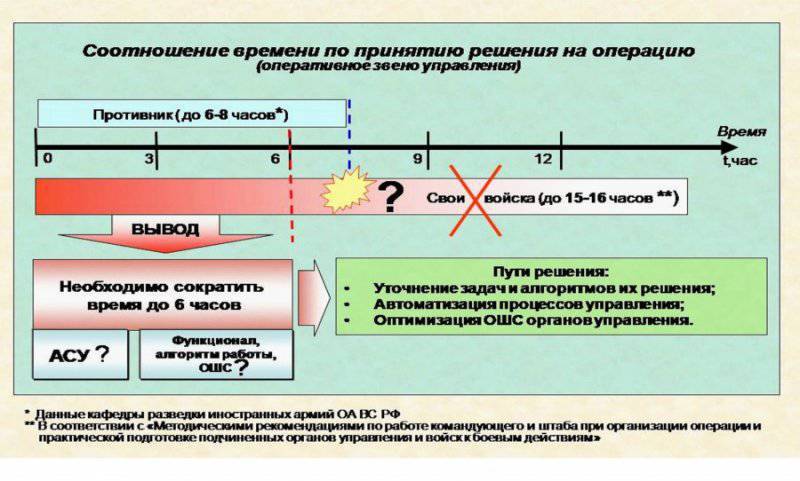
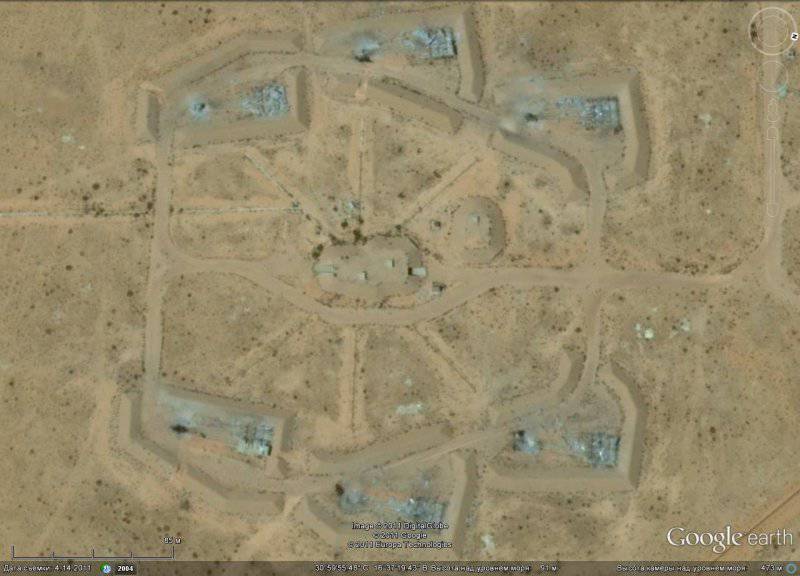
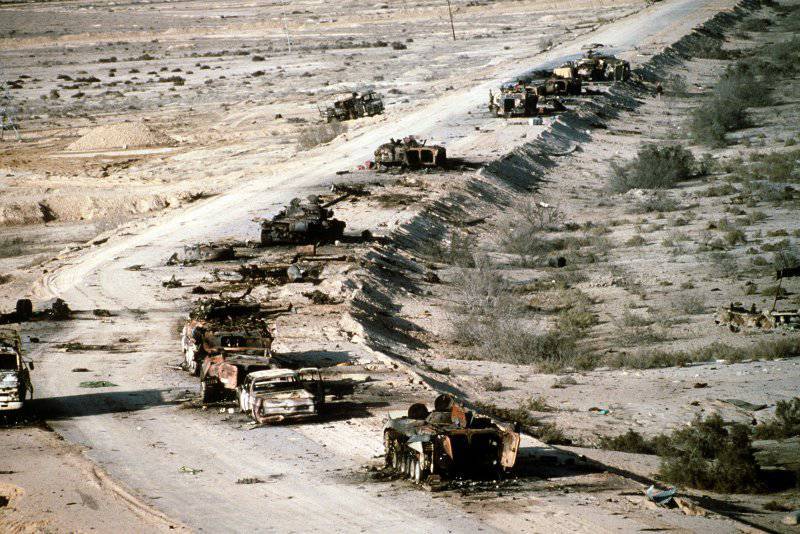
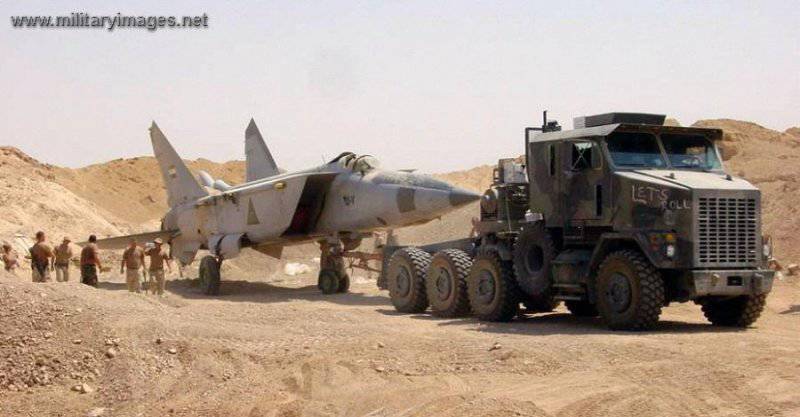

Information